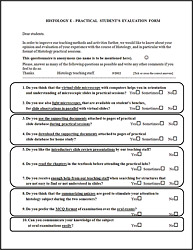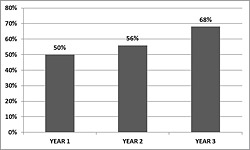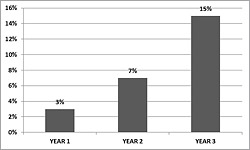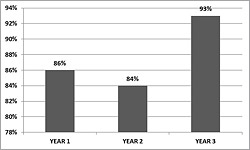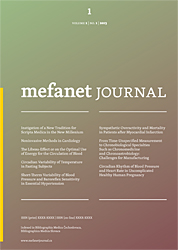
MEFANET Journal 2013; 1(1): 15–18
ORIGINAL ARTICLE
A long-term student’s evaluation of the new e-learning method of teaching histology practical
Radka Lichnovská*, Drahomíra Černochová, Běla Erdösová, Dimitrolos Krajčí
Department of Histology and Embryology, Faculty of Medicine and Dentistry, Palacký University in Olomouc, Olomouc, Czech Republic
* Corresponding author: radka.lichnovska@upol.cz
Abstract
Article history:
Received 29 March 2013
Revised 23 April 2013
Accepted 24 April 2013
Available online 2 May 2013
Peer review:
Josef Feit, Irena Lauschová
 Download PDF
Download PDF
We introduced a new method of teaching practical histology using virtual slides (VS) at the Department of Histology and Embryology in Olomouc. In the database of e-practical sessions there are sets of virtual slides for each topic taught, and several supporting documents available to students that help them to orient easily in the subject of the practical session. We have also introduced practical examination of histology slides with electronic tests on personal computers (PC). We have prepared our own specific set of evaluation questions and allowed students to evaluate this new method of practical sessions. The results of these anonymous questionnaires are of a great importance to our teaching staff, as they represent an important feedback for further improvement of teaching practical histology. Comparing student´s responses in three subsequent academic years, we have found no changes in their highly positive evaluation of the use of PC for observation of virtual slides. Increase in positive responses were observed in answers to questions concerning the use of supporting documents attached to the database of virtual slides (from 50% to 68%) and active preparation of students prior to practical sessions (from 3% to 15%). Students also admitted that they increasingly benefited from the in-course electronic testing (from 86% to 93%) that motivated students to more systematic studies during two semesters of the histology course. They unequivocally preferred electronic forms of examinations over oral ones. On the other hand, students agreed that they were not able to express their theoretical knowledge properly in oral discussions or exams.
Keywords
histology, virtual slides, e-learning, PC testing, evaluation
Introduction
Information explosion in biomedical fields and progress in technical applications enable to specify diagnostic and therapeutic strategies and to move them towards cellular and subcellular levels. These given circumstances must be transferred into the pre-gradual education of medical and non-medical professionals. The effort to change present technologies of education belongs to the characteristic feature of the current pre-gradual teaching of medicine and related biomedical disciplines, especially morphological subjects.
We introduced a new method of teaching practical Histology at the Department of Histology and Embryology in Olomouc. This method is based on the use of digital equivalents of traditional glass slides, called “virtual slides” (VS) [1]. The implementation of virtual slides in practical sessions is one objective of the unique project supported by European Social Fund grant. Students also have to use accompanying supporting documents which help them to orient easily in histological specimens observed during practical sessions. We have also introduced practical examination of histology slides with electronic tests on PCs. Students of both general medicine and dentistry study programmes have had an opportunity to evaluate the new way of teaching histology in anonymous questionnaires at the end of this subject.
Figure 1: Evaluation Questionnaire
Figure 2: Supporting documents. Do you use the supporting documents attached to pages of practical slide database during practical sessions?
Figure 3: Active preparation. Do you read the chapters in the textbook before attending the practical labs?
Figure 4: In-course testing and motivation. Do you think that the summarizing quizzes are good to stimulate your attention to histology subject during the two semesters?
Methods
Glass histology slides have been scanned with Olympus dotSlide scanning system [2] using standard 40× objective lens, creating thousands of overlapping images. The VS images are viewed on student’s PC as a single image map at variable magnifications using free dedicated viewer software (Olyvia, Olympus). Technical setup of our histology practical classroom consists of 1 server PC (teacher) and 30 client’s PC (students). The core of this virtual slide learning system is our own “Database of Histology Practical” that is build up in MS Excel document format [3]. Each practical session contains a set of virtual slides with slides properties, keywords, file size information and overview pictures of virtual slides. Additional supporting documents in pdf and ppsx format are available for each of the histology topic. These documents are as follows: “Guide to the Practical Session”, “Teacher’s Presentation” for pre-lab session, “Presentation of Electron Micrographs”, and a folder of movies, animations, and embryology notes. Moreover, classical binocular light microscopes are available for each student in the class to revise and compare the virtual and optical microscopy images of histological structures.
For electronic testing of student’s practical knowledge we use a special software Articulate Quizmaker’09 [4], which enables to prepare text and picture templates of questions and set important parameters of each test (minimal limit for passing the quiz, whole time score, etc.). This software has a selective option to shuffle sequences of questions and also to shuffle all distracters in the quiz randomly on monitors of client’s PCs. Owing to this, a lateral communication and cribbing was minimalized and therefore, one version of histology test was enough to prepare for one practical class. This software also scores the test automatically and displays the final results at the end of the test. This gives an objective evaluation of student’s results.
The evaluation questionnaire (Figure 1) contains in total 10 questions that concern benefits in the use of VS as compared to classical glass slides (q. 1–2), the use of supporting documents during and after the practical session (q. 3–4), evaluation of teacher’s and student’s activity during practical sessions (q. 5–7) and benefits of in-course electronic testing of practical skills and knowledge in multiple choice questions (MCQ) format (q. 8–9). One question is aimed at student’s capability to express their theoretical knowledge properly in oral examinations (q. 10).
Results
Comparing student’s responses in three subsequent academic years concerning the benefits in the use of virtual slides and classical glass slides, there were no changes in their highly positive evaluation of this new method. Increasingly positive responses were also in their use of supporting documents (Figure 2) attached to the database of virtual slides (from 50% to 68%) and active preparation of students prior to practical sessions (from 3% to 15%) (Figure 3). Students also admitted that they increasingly benefited from the in-course electronic testing (from 86% to 93%) that motivated students to more systematic studies during two semesters (Figure 4). They unequivocally preferred electronic forms of examinations over oral ones. On the other hand, some of students agreed that they were not able to express their theoretical knowledge properly in oral discussions or exams.
In their free comments at the time of the evaluation students expressed their positive attitude towards this new method by following statements: “Computer usage is more efficient compared to manual microscope”. “Histology method of teaching involves all senses of mine, including seeing, listening, hearing and more importantly observation and understanding”. “Now, Histology can be more interactive between students and professors”.
Conclusion
Students of both General Medicine and Dentistry programmes readily accepted the use of computers for observation and description of virtual slides. They represent a “computer-trained” generation of future medical professionals that is able to utilize fully the capability of modern PC technology and absorb information from new software applications easily. Majority of students evaluated positively the use of virtual slide. They also benefited from using the attached supporting documents during practical session and self-studies. They also admitted that they benefited from the in-course electronic testing, as they became motivated to more systematic studies during both semesters. Regarding PC-based examination, most of the exposed students preferred practical examination in MCQ format over the classical oral examination. This may be also related to the recent trend of decreasing capability of students to express their acquired knowledge orally, regardless of the subject they study. Teacher moderated in-group discussions with students over displayed virtual slides in practical sessions could be a good remedy for this negative trend.
Up to now, experiences gained from the application of PC technology in teaching practical histology reveal that implementation of virtual slides seems to be a modern and didactically effective tool for student’s motivation and activation. Students can participate in practical sessions more actively by comparing and discussing the observed structures with their classmates and teachers. Moreover, the teaching procedure using modern PC technologies creates a good condition for active forms of study and revisions outside the regular teaching hours through the internet connection to the database of virtual slides [5,6]. The interactive PC form of teaching morphological subjects (such as Histology) prefers an active dialog between teacher and student over a passive memorizing of data, and forms a knowledge-based foundation for further clinical practice.
Acknowledgements
This project has been supported by European Social Fund, and Ministry of Education, Youth and Sports of the Czech Republic: „Introduction of practical teaching of histology and embryology in an e-learning environment”, grant no. CZ.1.07/2.2.00/28.0089.
References
[1] Triola MM, Holloway WJ. Enhanced virtual microscopy for collaborative education. BMC Med Educ 2011; 11(4): 1–7.
[2] Olympus dotSlide Virtual microscope. [Online]. Available at WWW: <http://www.olympus-europa.com/microscopy/en/microscopy/components/component_details/component_detail_11267.jsp>.
[3] Krajčí D, Pospíšilová E, Černochová D, Kopečný T, Pop A. Histology practical in electronic format of virtual slides. In: Schwarz D, Komenda M, Štípek S, Mihál V, Dušek L (eds). MEFANET Report 04. Efficient multimedia teaching tools in medical education. Masaryk University: Brno 2011: 60–68. ISBN 978-80-210-5539-1.
[4] Articulate Quizmaker’09. [Online]. Available at WWW: <http://www.articulate.com/products/studio.php>.
[5] Olympus Net Image Server SQL for virtual slide microscopy. [Online]. Available at WWW: <http://www.olympus-europa.com/microscopy/en/microscopy/components/component_details/component_detail_24257.jsp>.
[6] HISTOLOGY_PRACTICAL database. [Online]. Available at WWW: <http://158.194.8.20/WebDatabaseClient/dbWebAccount.aspx>. Login credentials: User Name: student. Password: student. Database: HISTOLOGY_PRACTICAL.
Please cite as:
Lichnovská R, Černochová D, Erdösová B, Krajčí D. A long-term student’s evaluation of the new e-learning method of teaching histology practical. MEFANET Journal 2013; 1(1): 15–18. Available at WWW: http://mj.mefanet.cz/mj-01130329.
This is an open-access article distributed under the terms of the Creative Commons Attribution-NonCommercial-ShareAlike 3.0 License (http://creativecommons.org/licenses/by-nc-sa/3.0/), which permits unrestricted use, distribution, and reproduction in any medium, provided the original work, first published in the MEFANET Journal, is properly cited. The complete bibliographic information, a link to the original publication on http://www.mj.mefanet.cz/, as well as this copyright and license information must be included.
